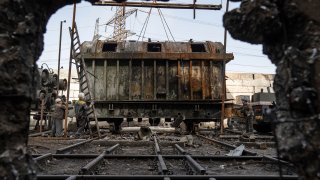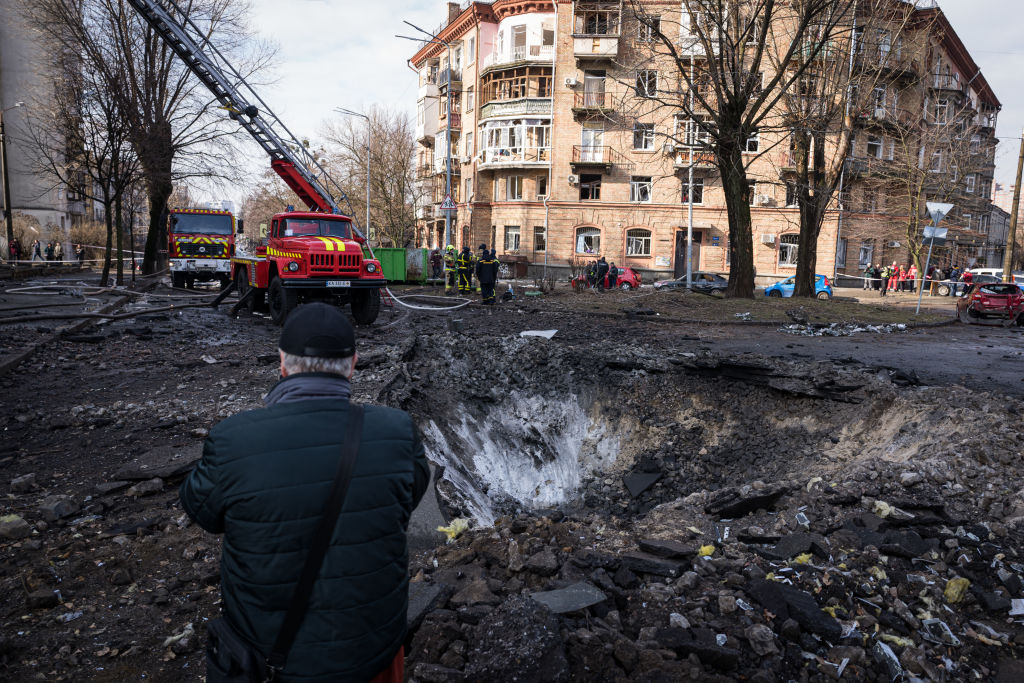
When the Russian barrage hit the Ukrainian power plant, a worker named Taras was manning the control panel — a crucial task that required him to stay as the air-raid siren blared and his colleagues ran for safety.
After the deafening explosions came a cloud of smoke, then darkness. Fires blazed, and shrapnel pierced the roof of the huge complex, causing debris to rain down on workers. Following protocols, Taras shut down the coal-fired plant, his heart racing.
In the March 22 attack, Russia unleashed more than 60 exploding drones and 90 missiles across Ukraine — the worst assault on the country’s energy infrastructure since the full-scale invasion began in early 2022.
The fusillade reflected Russia's renewed focus on striking Ukrainian energy facilities. The volume and accuracy of recent attacks have alarmed the country's defenders, who say Kremlin forces now have better intelligence and fresh tactics in their campaign to annihilate Ukraine's electrical grid and bring its economy to a halt. Moscow has also apparently learned how to exploit gaps in Ukrainian air defenses.
Get top local stories in Connecticut delivered to you every morning. Sign up for NBC Connecticut's News Headlines newsletter.
With more assaults inevitable, officials are scrambling for ways to better defend the country's energy assets.
The March 22 attack — which left 1.9 million people without power, according to analysts — was among the most intense in Russia's springtime air campaign targeting civilian infrastructure.
DTEK, Ukraine’s largest private energy company, lost 80% of its power generation capacity in attacks on March 22 and 29, the company said. Plants were destroyed across the country. Russia targeted transmission networks as well.
The bombardment blacked out large parts of Ukraine — a level of darkness not seen since the first days of the full-scale invasion. The strikes also tested Ukraine’s ability to make quick repairs.
The Associated Press was given access to two DTEK power plants damaged in the March 22 attack on the condition that the names and locations of the facilities and the full names of workers not be mentioned due to security concerns. The AP was not permitted to provide technical details of damage, including the number of missiles that struck each plant or whether the plant could still function.
After previous assaults, power station workers were able to restore service fairly quickly. But that became harder after March 22 because of continuing strikes that prevent rebuilding.
The Kharkiv region, which borders Russia and was the hardest hit, is still enduring power outages weeks later. On Thursday, drones struck the region's Zmiivska power plant, plunging 350,000 people into the dark.
“They are trying to take us back to the 17th century,” said Serhii, a manager in one of the power plants that was attacked.
Maksym Timchenko, the CEO of DTEK, inspected the grounds of one of the two power stations. Gazing up at the titanic complex, his eyes rested on a gaping hole in the building’s scorched facade.
Inside, workers collected debris in wheelbarrows, their faces blackened by floating dust. Cranes removed giant shards of twisted metal and blocks of fallen concrete. In the dark bowels of the plant’s interior, where an intricate network of large pipes connect to industrial boilers, the steel roof was so pockmarked with shrapnel it resembled a starry night sky.
“I’ve never seen in my life this level of destruction in a power station, and unfortunately it happened to us,” Timchenko said.
He estimates that the company can restore half of the damaged units in two to three months. It’s a Sisyphean task: Workers must repair damage over and over again.
This particular plant was targeted late last year, and one unit was destroyed. Timchenko said DTEK planned to repair it by the end of this year.
“But now the same level of destruction has happened to several power units,” he said, bringing the plant and the company’s strategic plans back to square one.
During the agonizing wait for more strikes, Ukrainian officials are discussing how to better protect power generators. One solution may be decentralizing them by creating a network of small facilities that are harder to hit than large plants.
The timing of the attacks perplexed many observers.
Russia usually reserves large-scale attacks on energy infrastructure for the peak winter months, when demand for heat is highest. A spring campaign suggests Russia was behind schedule in unleashing new tactics, said Oleksandr Kharchenko, director of the Kyiv-based Energy Industry Research Center.
“I am absolutely sure that they wanted to do this one month before,” he said.
Russia, as expected, targeted energy infrastructure in the last three months of last year, when temperatures dropped below freezing. But the high-voltage grid was prepared to sustain the attacks, and damaged sites were quickly repaired. In December, Russia accepted that the old tactics were not working.
As the winter months went by, Russia began concocting a new scheme.
“They did a huge intelligence job,” Kharchenko said, pointing to the precise nature of the attacks and the damage done. The Russian military seemed to “know everything about the current status of many energy infrastructure objects," including their defenses.
Once the targets were chosen, Russia swarmed them with missiles at an unprecedented scale. If before they launched three drones and two missiles per target, now they send six missiles and up to 15 drones, he said.
Air-defense systems could not stop everything. "It was too much,” he said.
Before the March 22 attacks, workers operated under the assumption that air defenses would take down 70% of air attacks. The strikes that got through often fell on the periphery of the plant, said Serhii, a plant manager.
"But now the circle is smaller and smaller, reaching our power units and control rooms,” Serhii said.
The result is dire. According to Kharchenko’s figures, Ukraine lost up to 15 percent of its power generation. That means, for now, it cannot cover the demand expected during the peak summer months of July and August.
In the aftermath of the attack on his power station, Taras was traumatized more by the scale of the destruction than the explosions that caused it.
“I wasn’t scared at first, but we got scared when we saw the consequences,” he said.
On the night of March 22, an injured worker was brought into the control room as fires blazed across the complex.
“With one hand, we conducted the shutdown, with the other we bandaged his injured leg,” he said. They left the plant using flashlights to navigate through pitch darkness.
“If the skies were protected, I would feel calmer,” he said. “Power infrastructure is something everything depends on. If there’s no power, nothing works: Plants don’t work. People are left without internet. You won’t even know when the missiles are flying at you.”
___
Associated Press journalist Volodymyr Yurchuk contributed to this report.



